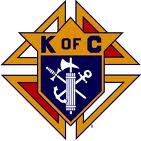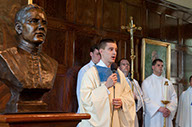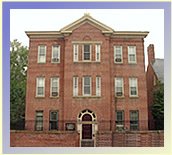Numerous causes for sainthood are underway, including several from the United States. Of particular interest for Sulpicians is the cause of Servant of God, Father Michael Joseph McGIVNEY (1852-1890), founder of the Knights of Columbus. During this Year for Priests, in particular, Father McGivney’s story has captivated many people, especially because it is an inspiring tale of a humble, holy and visionary parish priest.
What is often not told of the story of this American priest of Irish ancestry is the incredible “French connection” via the Sulpicians that helped to define his priestly vocation. It is a tale worth telling.
Born in 1852 in Waterbury, Connecticut, a factory town largely dominated by non-Catholics, Michael McGivney was the oldest of twelve children. His parents were two young Irish immigrants who had come to the new world in 1849 seeking a future filled with hope. Raised in a strong Irish-Catholic family, Michael was attracted to the priesthood as a boy. He was encouraged and influenced by a strong-willed parish priest from Ireland, Father Michael O’Neile, pastor of the local parish.
By the age of sixteen, McGivney knew that he was called to the priesthood. Although his family, especially his father, resisted the idea, he was finally allowed to enter seminary. Because of a strong influx of French-speaking immigrants from Canada to New England, McGivney and some other young men from Connecticut were sent to Quebec, Canada, to begin seminary formation rather than to Baltimore, Maryland, the customary destination for New England seminarians at the time. The bishop had hoped to have his future priests trained to minister properly to the French-speaking immigrants. Thus, McGivney was sent to a school run by the Jesuits in Saint-Hyacinthe, a small town near Montreal, Quebec, Canada. That was McGivney’s first French connection, with the language and culture of “New France.” There was to be a second connection, even more profound.
After a time in the seminary in Quebec, McGivney took a year off from studies for further discernment. His vocation had not yet solidified. As a bright and capable seminarian, and with some influence from his professors, he had toyed with the idea of becoming a Jesuit but was also attracted to parish ministry. After the year off, he returned to seminary, this time attending Our Lady of the Angels Seminary run by the Vincentians, but was soon sent by his bishop to Saint Mary’s Seminary & University in Baltimore. Saint Mary’s is the oldest Catholic seminary in the U.S., founded by the Sulpicians in 1791 at the invitation of John Carroll, the first Catholic bishop of the U.S.
 In Baltimore, McGivney encountered another French heritage through his four years of priestly formation (1873-1877) under the Sulpicians, the order founded in Paris in 1641 for the formation of priests. Quoting a priest who knew McGivney well, the biography comments of him:
In Baltimore, McGivney encountered another French heritage through his four years of priestly formation (1873-1877) under the Sulpicians, the order founded in Paris in 1641 for the formation of priests. Quoting a priest who knew McGivney well, the biography comments of him:
To them [Sulpicians] he unfolded his mind anew, and they, finding in him the ideal vocation, diverted him entirely from the thought of joining the Jesuits. The arena of stirring toilers rather than that of placid thinkers was the sphere best adapted to qualities and energies such as were his, they argued; and so, while praising scholarship as a possession of great value, they taught him to regard it as merely a subsidiary quality in a priest—humanity, and not the humanities, should engage henceforth his most devoted study; sympathy for human woes was a property more intrinsic than knowledge; to store up knowledge was good, they admitted; but to save souls was incomparably better. (D. Brinkley and J. M. Fenster, Parish Priest [William Morrow, 2006], 54-55)
This second French connection was truly life-changing for the young man. The strict and rigorous formation program run by the Sulpicians, with it emphasis on both spiritual and academic excellence, served Father McGivney well. As a priest was to remark later: “…having the benefit of American and French culture added to his Irish background, the silent, determined and pious Michael Joseph McGivney was well prepared to be ordained a secular priest.” (Parish Priest, 55)
When he returned to his diocese after his ordination in Baltimore at the historic Basilica of the Assumption, his identity as a parish priest had been firmly shaped by his Sulpician mentors. He was also influenced by the economic hardships and racial unrest he witnessed during his seminary formation in Baltimore. McGivney would go on to make history as a priest who saw and responded to the needs of the poor in his parish and his diocese. As his Sulpician teachers had taught him, priests are called to follow Jesus as perfectly as possible. He was exemplary in his priestly ministry, as witnessed by his piety and his constant care for his flock.
Intelligent as he was, Father McGivney might have made significant contributions to the academic study of philosophy or theology, had he become a Jesuit. His second and more influential “French connection,” however, steered him in a different direction. His place in history is now marked more significantly by an organization that has become one of the most successful charities ever established, the Knights of Columbus.
As an incredibly visionary 29-year-old pastor, he founded the Knights in 1881 specifically to help those in financial difficulties, often in his day, new immigrants who had few resources to rely on for health care, life insurance, and the like. He knew from personal experience after the death of his own father how important it was for others to offer assistance to families in need, since he had personally benefited from others’ generosity to allow him to continue his seminary studies. Now the 1.8 million member organization continues applying Father McGivney’s vision throughout the world through its life insurance program and other charitable activities.
The Society of Saint Sulpice is enormously proud of Father McGivney. His alma mater, St. Mary’s Seminary in Baltimore, recently dedicated a bust of Father McGivney to honor this outstanding alumnus and the strong ties with the Knights of Columbus who continue to support contemporary seminarians, especially with prayer and scholarships.
In 1969 the seminary program at St. Mary’s on Paca Street was consolidated to the Roland Park campus where it exists today. The Paca Street site is now maintained and preserved by the Sulpicians as Saint Mary’s Spiritual Center & Historic Site on Paca Street.
 The site is unique within the history of the Catholic Church in the United States. Not only is it the home of the first Catholic seminary in the nation (1791), but it was also home to the first U.S. born saint, Elizabeth Ann Seton (1808), who founded her school in the “Seton House” given to her by the Sulpicians for her ministry that led to the founding of the Sisters of Charity of Saint Joseph’s.
The site is unique within the history of the Catholic Church in the United States. Not only is it the home of the first Catholic seminary in the nation (1791), but it was also home to the first U.S. born saint, Elizabeth Ann Seton (1808), who founded her school in the “Seton House” given to her by the Sulpicians for her ministry that led to the founding of the Sisters of Charity of Saint Joseph’s.
Moreover, the lower seminary chapel (“chapelle basse”) was the birthplace of the first African-American Catholic community (1797) and the first community of African-American sisters (Oblate Sisters of Providence, founded by Mother Mary Lange and a Sulpician priest, J.H.N. Joubert, in 1828). The old convent, built in 1897, now serves as the office of the Spiritual Center, which offers a variety of spiritual programs for individuals and groups. A new Visitor Center, containing information on Fr. McGivney and the other holy men and women who once called the site home, has been erected to welcome visitors.
St. Mary’s on Paca Street offers visitors and pilgrims alike an exceptional opportunity to walk back in time to the early days of the Catholic Church in the United States. To tour the Mother Seton House and the historic Seminary Chapel is to walk where saints have walked, prayed, and lived. Indeed, there is a special Father McGivney walkway with inscribed pavers from donors, especially various Councils of the Knights of Columbus.
The Society joins in prayer for the beatification and canonization of this great American priest! Father McGivney, pray for us!



